|
 Nederlands
/
Dutch Nederlands
/
Dutch
Euphorbia
The euphorbia
is often confused for a cactus. But it isn’t.
Cacti are native only to the Americas and the succulent euphorbia family
(Euphorbiacea) is native to Africa.
To the family euphorbia belong in contrast to the cacti also "ordinary"
plants.
There are in Holland garden plants, which belong to this family.
Also the well-known poinsettias
(Euphorbia pulcherrima) and the
weeds sun spurge are euphorbias.
The name, Euphorbia, comes from King Juba of North Africa, who dedicated the
plant in honour of his doctor Euphorbus.
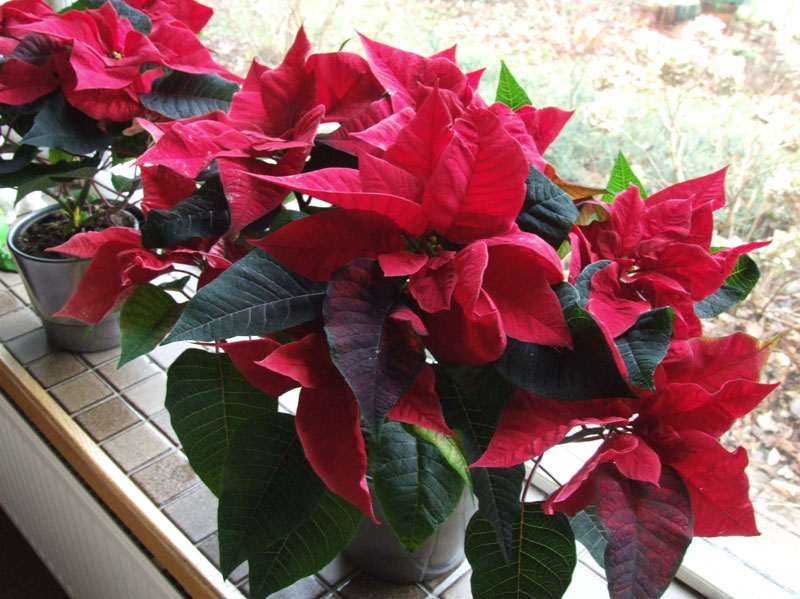
Pointsettia, Christmas flower, Lobster flower, Mexican flame leaf.
(Euphorbia pulcherrima)
In the Netherlands you can only buy this plant in December (Chrismas).
The red parts of the poinsettia, the bracts, are actually modified leaves.
Nowadays there is a wide array of other colors available. The small yellow
flower is situated in the middle of the bracts.
Indirect sun and not to much water.
When you also want flowers next year: In May you can stop watering. When
it drops its leaves, you have to cut the poinsettia
back and to repot it.
Beginning October the plant must be kept in complete darkness
for 14 continuous hours each night. After 40 days of this treatment, the
plant can be kept in normally
lighted rooms. But you can also buy a new Pointsettia, for they are cheap.
The poinsettia is a native plant
of Mexico Central America. The bushes can grow to approximately 4 m high.
|
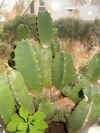
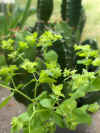
A sun spurge (euphorbia
helioscopia) had come up at a hibernating euphorbia resinifera.
As many succulent euphorbias it has many side
arms. At the end of April I have made an
other photo. |
Most succulent Euphorbiaceae contain a poisonous sap which exudes from the tiniest injuries or
sometimes even when only touching the plant. Typically this sap is milky white
and sets into a latex.
In
some species the poison is only mild, but in others it is dangerous. Irritant
for skin and eye.
There
are many shapes and sizes (shrubs, trees, columns, balls, ground
cover, medusa head)
Medusa head forms heads with lots of limbs growing from the head,
hence its name medusa for the Greek goddess with snakes for hair.
The leaves are small and have a short life.
Often they have spines for protection. Leaves in the succulent species are usually reduced or deciduous.
Stipules are usually present, often modified into prickles and spines.
Flowers are small. But sometimes surrounded by beautiful showy bracts
From the most species you
can take cuttings. First the cutting
will dropping latex. But after couple of minutes the flow will stop, and then you have to
clean the cutting with water. After the wound has been cleaned, the cutting
should be left to heal for a week or two. This period reduces the risk for
the stem to rot. Rough sand is a good media for your cuttings. After 6
weeks, the cuttings should have developed a root system.
Unlike
cactuses Euphorbias can grow in ordinary potting soil. They
often prefer peat-based
potting mixture.
The family contains over 2000 species!
Some good sites
are:
Plants Belonging to the Genus
'Euphorbia'
Sukkulente Euphorbien
Rikus van Veldhuisens und Jaap Keijzers U4BA
Still it is difficult to
find the right name of your euphorbia. For there are so many species.
In summer most Euphorbias are in the garden, or on
the terrace. It was remarkable, they had damage of the sun in the hottest month in 2006 and not of the
Dutch bad weather.
|
 . .

Canary Island Spurge (Euphorbia
canariensis) Native of course to the Canary islands. It can reach a height
of three meters. Hardy to -2°C. Dark red flowers. It’s one of the more poisonous
spurges.
|
|
 . .

Pencil tree or milk bush
(Euphorbia
tirucalli) A bush or tree, up to 6 m tall. But
it can be pruned. Hardy to -4°C for short periods.
Native te east Africa.
|
|
 . .

African Milk Barrel (Euphorbia horrida)
(I think) There are many varieties of this species. After some years it is
sending up new stems from the base perhaps to form a small colony. This
euphorbia is dioecious (there are male and female plants)
|
|
 . .
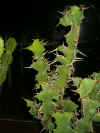
Bigthorn Euphorbia,
Big Horned Euphorbia, Cow Horn
(Euphorbia grandicornis). It can reach 2 m height. It ‘s a much-branched shrub. The branches are deeply constricted.
|
|
 . .

Euphorbia
enopla or heptagon.
These species are similar. A clumping plant with stout finger sized stems.
Native to South Africa. Both
shrubs are about1 m. tall.
|
|


 flower on spine 16-4-2014
flower on spine 16-4-2014
|
|
 . .

River
Euphorbia (Euphorbia
triangularis) They typically have stout green-angled stems with
between three and five flat sides. Height: 4 m.
Native to South Africa.
|
|
 . .

African
Milk Tree (Euphorbia
trigona) The cactus-like brances (with tiny spines and small leaves on the
tip) start from the sides and get erect, growing upwards, up to 2,5m.
Native to South Africa.
|
|
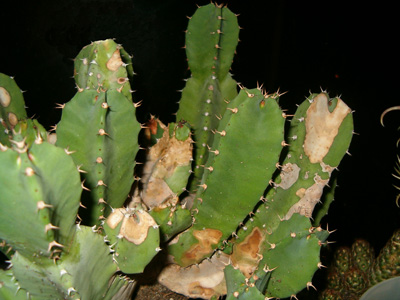 . .

Resin spurge,
Officinal Spurge (Euphorbia
resinifera) I think. It
is a shrub growing to 60 cm tall, forming multi-stemmed cushion-shaped
clumps up to 2 m wide. The stems are erect. Native to Morocco.
Officinal: It is
one of the oldest documented medicinal plants.
|
|
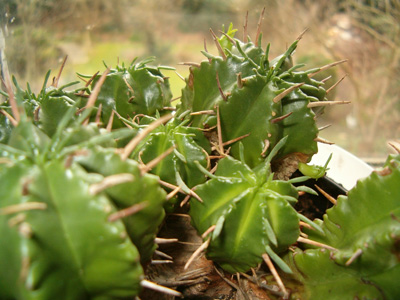
Euphorbia
valida I
have this euphorbia for some years already. It forms clumps to 1 m wide. My
plant remains small.
Native to South Africa.
|
|
 . .
 . .

Euphorbia
pseudocactus.
A multi-branched succulent shrub with
white spines,
which is its name suggests resembles a cactus. Height 1 m. In 2006 it was
flowering in February, March. In 2007 it was flowering in the garden in
July.(top part of the plant)
Native to South Africa.
|
|
 . .
 . .

Medusa
head (Euphorbia
caput-medusae) I
don’t know witch. There are more species. The flowers on the photo are
small.
Native to South Africa. |
|
 . .
 . .

Crown of Thorns (Euphorbia
Milii). This little shrub is
a popular house plant. Many varieties and hybrids are available varying in
flower size and color from red to yellow. It blooms freely most of the
year. Native to Madagascar. Height 1 m.
|
|
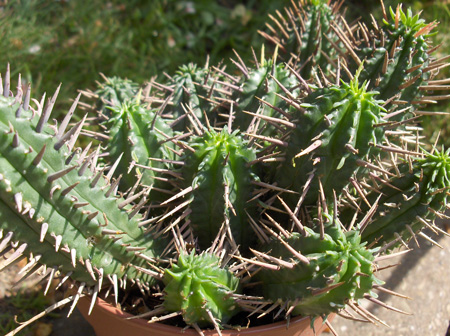
Euphorbia submammillaris. Miniature succulent
shrub, clumps can be over 50 cm in diameter, stems are around 1 cm in
diameter and 10 cm long.
Native to South Africa.
|
Here you can find much more photos of Euphorbias!!
Nederlands /
Dutch
 
|
